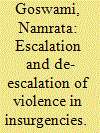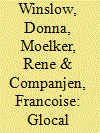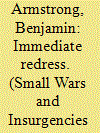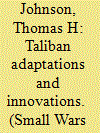|
|
|
Sort Order |
|
|
|
Items / Page
|
|
|
|
|
|
|
| Srl | Item |
| 1 |
ID:
119503


|
|
|
|
|
| Publication |
2013.
|
| Summary/Abstract |
There have been growing claims in media circles and law-enforcement settings that street gangs and criminal groups are turning to Internet-based social networking sites for various reasons ranging from the showcasing of their images and exploits to the suspected recruitment of members. The present study investigates whether such a trend is, in fact, in place. The presence of street gangs on these Internet sites is referred to as cyberbanging. While there is some anecdotal evidence suggesting that gangs are turning to social networking sites, there is little available research on exactly how street gangs and criminal groups use the Internet. Our main argument is that gang culture is in many ways an individualized phenomenon and this feature ties in directly with recent assessments of the Internet as a setting that is governed by a process of networked individualism. This theoretical link between the individualized gang setting and the presence of gang members on social networking sites helps us understand why recruitment is improbable even in a context where people are openly diffusing their image and exploits to a growing number of Internet users. The empirical segment of this research adds to this general outlook. Based on a keyword search of over 50 street gang names, the three main social networking sites (Twitter, Facebook, and MySpace) were monitored for street gang presence. Results illustrate that gang presence on social networking sites is linked primarily to promoting a general gang or street culture through individual displays. In regard to the visitors to such sites, there is no evidence that they are being tricked or manipulated in any way. They are, however, showing their curiosity in regard to such groups and, for those who share their comments and opinions, signs of support are evident. Thus, whereas criminal gangs are not proactively using the Internet to convert anyone into being gang members, social networking sites are creating a new venue for people who share or are sensitive to the values underlying street gang lifestyle to come together. These sites essentially create a new convergence setting for gang members to interact with a wider number of people who would probably never have been exposed to their lifestyles and exploits through physical interactions. The study's conclusion extends these findings toward further research in this area, as well as outlining the more relevant implications for law-enforcement monitoring of this growing phenomenon.
|
|
|
|
|
|
|
|
|
|
|
|
|
|
|
|
| 2 |
ID:
119498


|
|
|
|
|
| Publication |
2013.
|
| Summary/Abstract |
Insurgencies in the Northeast of India have been a recurring phenomenon since India's independence in 1947. One of the most significant aspects of the multiple insurgencies has been the use of violence for political goals. By drawing upon three cases of insurgencies in Northeast India, the article offers a conceptual framework on escalation and de-escalation of violence in insurgencies. The article argues that the most critical variables which have a direct bearing on the levels of insurgent violence are: popular support, loss of legitimacy and the state's counter-response.
|
|
|
|
|
|
|
|
|
|
|
|
|
|
|
|
| 3 |
ID:
119502


|
|
|
|
|
| Publication |
2013.
|
| Summary/Abstract |
In Chechnya a protracted conflict only seemingly quieted down, but it still smolders and as the conflict is suppressed by coercion, it is inevitable that it will flare up at some time in the near future. The root causes of the conflict can be understood by use of globalization theory, which dialectically brings together the clashing forces from above and below. Civil society in Chechnya deteriorated, is politically curtailed, and has no resilience left. It thus results in a frozen conflict and an excluded and victimized society. Russian-style reconstruction does alleviate living conditions, but does not remediate the frozen conflict character of the present situation. The dynamics of the globalizing forces from below and above, summarized in the glocalization concept, not only explains the resistance by the Chechen people, for whom revolt, rebellion, and terrorism remain attractive options, but also serves as a model for other insurgencies. Reflecting on the two recent Chechen-Russian wars results in a paradigmatic case study.
|
|
|
|
|
|
|
|
|
|
|
|
|
|
|
|
| 4 |
ID:
119504


|
|
|
|
|
| Publication |
2013.
|
| Summary/Abstract |
Maritime interests in the twenty-first century are not immune to the growing number of irregular challenges and hybrid threats that have come to dominate land warfare. In order to better understand these challenges a study of naval history can help provide a vital foundation. In the early 1830s the United States Navy dispatched the frigate USS Potomac to Sumatra to investigate a pirate attack on the spice trader Friendship. Potomac's crew of sailors and Marines conducted a landing at the village Quallah Batoo and fought a pitched battle. As the navies of the world approach naval irregular warfare in the new century, studying past examples like Potomac's mission can help illuminate the principles of successful naval irregular warfare.
|
|
|
|
|
|
|
|
|
|
|
|
|
|
|
|
| 5 |
ID:
119501


|
|
|
|
|
| Publication |
2013.
|
| Summary/Abstract |
The lessons from the two French counterinsurgencies, Indochina and Algeria, give rise to a new understanding of the projection of airpower in remote and hostile environments and the purpose, design, and use of aircraft in counterinsurgency. In both Indochina and Algeria, the campaigns were ones of poverty, and it is their imaginative management under severe resource constraints that provides thoughtful and applicable lessons for today. In both cases, airpower held the promise of delivering victory and solving the resource issue. In Indochina, acquisition of the needed aircraft, operating knowledge, and experience came too slowly to realize this promise. In Algeria, the French embraced the lessons from Indochina and were quite successful and innovative in the use of airpower. The lessons can be reduced to four requirements: (1) a network of airfields for liaison, ground-support, and intra-theater airlift to enable effective air support of ground forces; (2) a solid, reliable, and simple ground-support aircraft capable of operating from forward airfields within range of ground engagements; (3) a capable intra-theater heavy-lift transport to supply the extended ground forces; and (4) helicopter capability to enhance tactical troop mobility and support.
|
|
|
|
|
|
|
|
|
|
|
|
|
|
|
|
| 6 |
ID:
119500


|
|
|
|
|
| Publication |
2013.
|
| Summary/Abstract |
Pirate attacks against commercial vessels in the Western Indian Ocean and nearby seas reached an unprecedented level in 2011. Despite concerted efforts by the international community and shipping companies to address this threat by conducting naval patrols and equipping commercial vessels with non-lethal defenses, the frequency of pirate attacks continues to increase. The general ineffectiveness of existing anti-piracy measures has sparked interest in expanding the use of armed private security contractors to protect commercial vessels from pirate attacks. This article argues that armed private security contractors can, indeed, enhance the security of commercial vessels because these actors can provide onsite protection for commercial vessels, which should allow them to respond very quickly to pirate attacks, and because these actors are willing to use deadly force against pirates. However, this article also argues that expanding the use of these actors may increase the degree of violence used during pirate attacks, pose threats to the safety of innocent civilians, and violate a number of domestic and international laws.
|
|
|
|
|
|
|
|
|
|
|
|
|
|
|
|
| 7 |
ID:
119497


|
|
|
|
|
| Publication |
2013.
|
| Summary/Abstract |
Since 1978, insurgents in Afghanistan have endured a state of constant conflict, facing two occupying forces that have fielded modernized, highly capable militaries with a multitude of numerical and technological advantages over them. The asymmetry of these conflicts drove a rapid cycle of adaptation and innovation on the part of the insurgents that continues today. The Taliban way of war and approach to governance focuses on turning populations against political weakness and fielding simple and effective governance at the local and provincial levels. The Taliban has proven to be a highly adaptive, innovative, and resilient organization, drawing on tactics from conflicts in Iraq, Pakistan, and their own experience in Afghanistan to fight an effective and enduring defensive jihad. The introduction of improvised explosive devices, suicide bombers, and more recently a rising rate of assassinations all demonstrate the Taliban's ability to adapt tactically and innovate at the strategic level. These innovations are even more significant when one considers the cultural, social, and ideological barriers to change and how the Taliban overcame those barriers to include in their arsenal formerly taboo actions, such as suicide bombing. Understanding the innovation shown by insurgents in Afghanistan provides critical insights into the conflict the US-led coalition faces today and how it may be fought tomorrow.
|
|
|
|
|
|
|
|
|
|
|
|
|
|
|
|
| 8 |
ID:
119499


|
|
|
|
|
| Publication |
2013.
|
| Summary/Abstract |
The assumption that an insurgency effort must culminate in the seizure of state power became the go-to cliché of the twentieth-century understandings of the Civil War. However, historical counterfactuals about Sudan's civil wars have cavilled at the accuracy of this postulate. This article argues that Sudan constitutes an outlier which does not perfectly fit this established convention. In essence, many factors have combined to be the sources of Sudan's intractable, periphery-originated civil wars. Since the Torit Mutiny in August 1955, virtually all these uprisings have exhibited deep failings in inducing a complete change in the centre; or separating any part of the country through military means. Succinctly put, they have, with no exception, ended in a negotiated settlement rather than through a decisive military victory by the rebels. Based on the findings of this study, state violence, ethnic politics, and power struggle among the rebels, as well as geography, geopolitics, and the permeability of the borders have emerged as key explanatory variables to this alternative hypothesis.
|
|
|
|
|
|
|
|
|
|
|
|
|
|
|
|
|
|
|
|
|